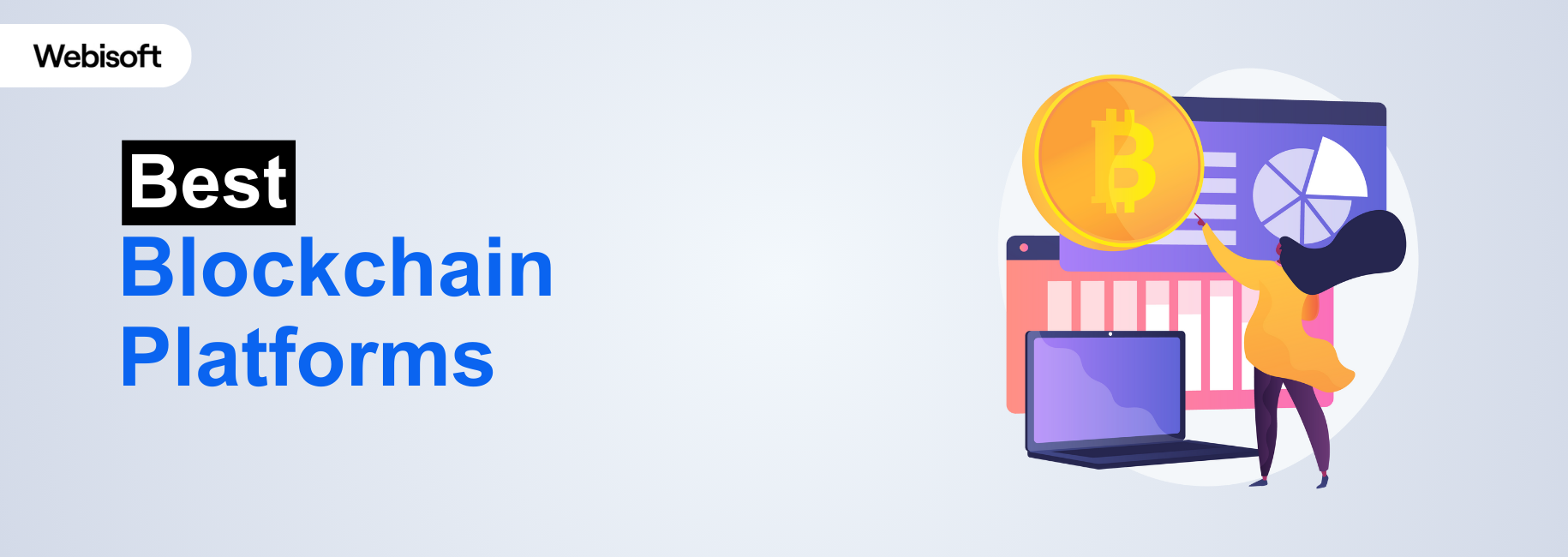Did you know that the global blockchain market is projected to reach $39.7 billion by 2025, experiencing a compound annual growth rate (CAGR) of 67.3%? Behind this growth, different types of blockchain platforms have great contributions. Are you now thinking about the best blockchain platforms?
The most popular blockchains platforms are:
- Ethereum
- Hyperledger Fabric
- IBM
- OpenChain
- Stellar
Here we’ve just mentioned 5 names but in this guide, we’ve discussed about 10 best blockchain platforms with proper details. Just read on and understand everything.
Contents
- 1 Leading Blockchain Platforms Based Market Insights & Investment Analysis
- 2 Top 10 Blockchain Platforms: Quick Overview
- 3 Criteria for Ranking the Blockchain Network List
- 4 List of 10 Popular Blockchain Platforms: In-Depth Overview
- 5 How to Choose the Ideal Blockchain Platform for Your Business?
- 6 What’s New in the Latest Blockchain Platforms
- 7 Conclusion
- 8 FAQs
- 8.1 Is regulatory compliance a concern for blockchain platforms like Ethereum and Hyperledger Fabric?
- 8.2 What are the energy consumption implications of platforms like EOS and Stellar?
- 8.3 How do Corda and Klaytn address interoperability with other blockchain networks?
- 8.4 What is included in a blockchain ecosystem list?
Leading Blockchain Platforms Based Market Insights & Investment Analysis
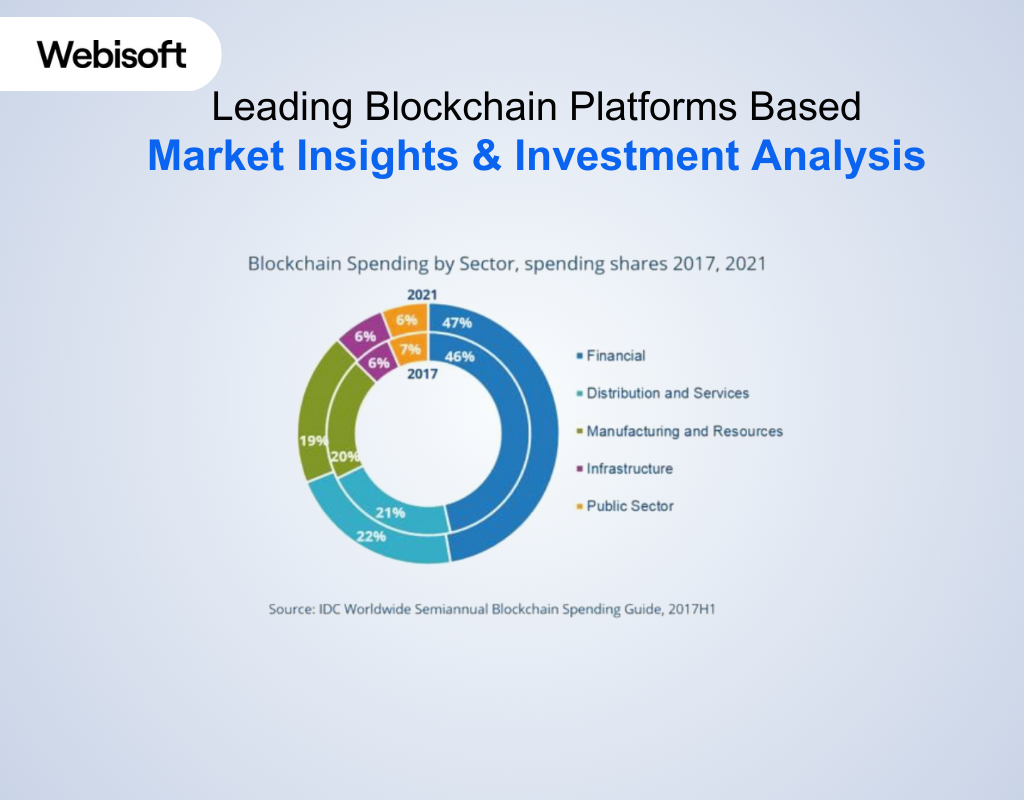
Interest in blockchain platforms has grown significantly, driven by their potential to streamline supply chains, enhance traceability, simplify trade, and improve financial transactions. This surge began with the speculative excitement surrounding Bitcoin, highlighting the challenges faced by older blockchain platforms in terms of energy consumption and speed.
Modern blockchain platforms have emerged to overcome these limitations, offering practical value across various business applications. Suseel Menon, a practice director at Everest Group, notes that enterprises are adopting blockchain platforms for applications requiring multi-party cooperation or data exchange.
These applications include supply chain tracking, trade finance, digital assets, and identity management, with some extending to ERP functions like vendor and supply chain management.
Alex-Paul Manders, a partner at Information Services Group, emphasizes that blockchain platforms’ evolution has heightened awareness of decentralized finance (DeFi). This, in turn, has the potential to disrupt traditional banking, finance, and supply chain finance models.
Manders predicts that blockchain platforms could disrupt legacy supply chain businesses and technology processes, particularly in industries with stringent tracking and tracing requirements, such as pharmaceuticals.
According to Suseel Menon, the top three blockchain frameworks for these use cases are R3 Corda, Hyperledger, and Ethereum. Additionally, Menon sees notable activity in using blockchain platforms to build certain functions of ERP, such as vendor management and supply chain management.
Top 10 Blockchain Platforms: Quick Overview
Explore the comprehensive quick overview of the top 10 blockchain platforms in the table below. This quick overview highlights their Consensus Mechanism, Smart Contract Support, and Token Standards, providing a concise guide for your blockchain journey.
| Blockchain Platforms | Consensus Mechanism | Smart Contract Support | Token Standards |
| Ethereum | Proof of Stake | Yes | ERC-20, ERC-721 |
| Hyperledger Fabric | Practical Byzantine Fault Tolerance (PBFT) | Yes | Hyperledger Composer |
| IBM | Consensus byzantine fault tolerance (CFTBFT) | Yes | IBM Blockchain Token Platform |
| OpenChain | Proof of Authority | Yes | No native standard, leverages existing standards |
| Stellar | Federated Byzantine Agreement (FBA) | Yes | Native Assets |
| EOS | Delegated Proof of Stake (DPoS) | Yes | ERC-20, EOSIO |
| Corda | Notary Service | Yes | No native standard, uses legal contracts |
| Klaytn | Byzantine Fault Tolerance (BFT) | Yes | KIP-7 (fungible), KIP-17 (NFT) |
| Tron | Delegated Proof of Stake (DPoS) | Yes | TRC-10, TRC-20 |
| Hedera Hashgraph | Hashgraph | Yes | HTS (fungible & NFT) |
Criteria for Ranking the Blockchain Network List
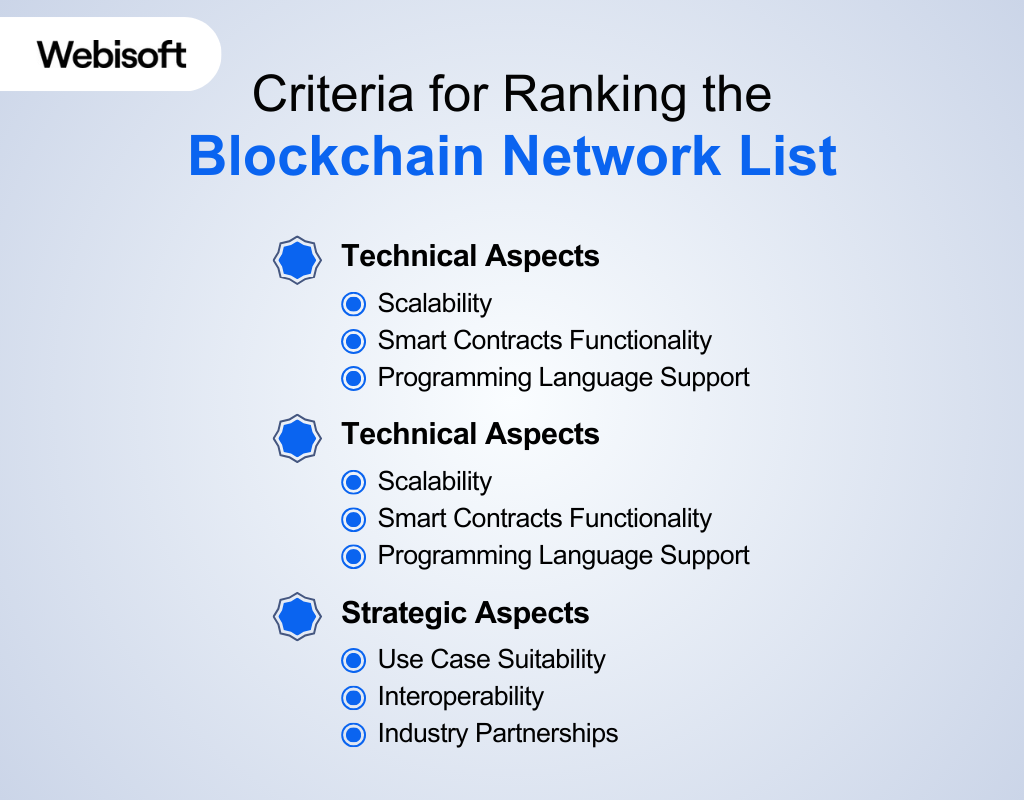
When it comes to evaluating and ranking blockchain networks, our approach involves a comprehensive analysis of various crucial criteria. These factors are instrumental in assessing the suitability of blockchain networks for diverse applications and industries.
Our criteria for ranking the blockchain network list involves technical, economic, and strategic aspects, providing a holistic view of each platform’s capabilities and potential.
Technical Aspects
In blockchain networks, technical aspects form the backbone. We’ll explore consensus mechanisms, scalability, smart contract functionality, and programming language support, ensuring a comprehensive understanding of each platform’s technical prowess
Consensus Mechanism
Evaluating the underlying consensus mechanism, such as Proof of Work (PoW), Proof of Stake (PoS), or other innovative approaches, to understand the network’s security and efficiency.
Scalability
Assessing the platform’s scalability in terms of transaction processing capabilities and its ability to handle a growing volume of transactions.
Smart Contracts Functionality
Examining the support for smart contracts, a crucial feature for executing automated actions and enforcing rules on the blockchain.
Programming Language Support
Considering the programming languages supported by the blockchain platform, ensuring compatibility with development teams and facilitating efficient application development.
Economic Aspects
Here we’ll analyze transaction costs, delve into tokenomics, and gauge adoption and community support. Uncover the economic foundations that drive these blockchain networks forward.
Transaction Costs
Analyzing the costs associated with transactions on the blockchain, a vital factor for businesses seeking cost-effective solutions.
Tokenomics
Understanding the economic model of the blockchain network, including token distribution, inflation rate, and mechanisms governing the platform’s native cryptocurrency.
Adoption and Community Support
Examining the level of adoption and community support, which reflects the platform’s acceptance and the vibrancy of its development community.
Strategic Aspects
Beyond the technical and economic aspects, strategic aspects shape the effectiveness of blockchain networks. We’ll evaluate use case suitability, assess interoperability, and delve into industry partnerships.
Use Case Suitability:
Assessing how well the blockchain platform aligns with specific use cases, such as supply chain management, trade finance, digital assets, or identity management.
Interoperability:
Evaluating the platform’s ability to interoperate with other blockchain networks and traditional systems, promoting seamless integration.
Industry Partnerships:
Considering partnerships with enterprises, institutions, and industry players, indicating the platform’s strategic positioning and potential for real-world applications.
List of 10 Popular Blockchain Platforms: In-Depth Overview
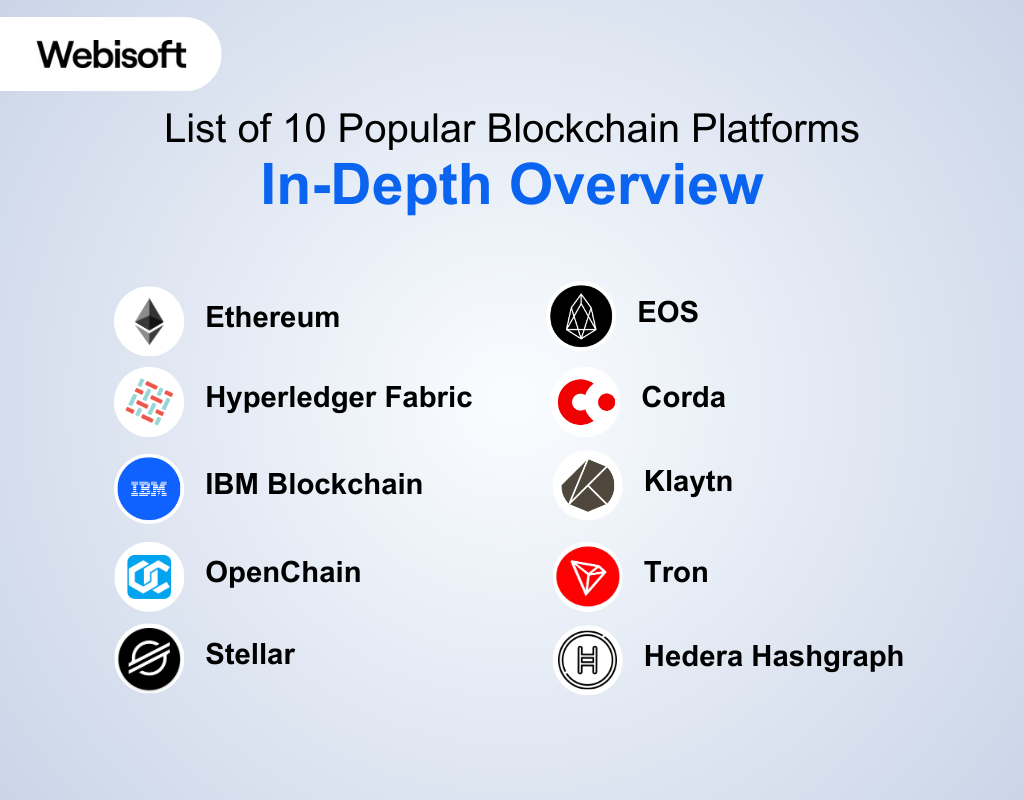
Blockchain technology has revolutionized various industries by introducing decentralized and secure solutions. Here’s a detailed list of blockchains platform, each with its unique features and capabilities:
Ethereum
Ethereum, launched in 2015, is a decentralized platform that introduced smart contract functionality, allowing developers to create and deploy decentralized applications (DApps). It operates on a blockchain with a native cryptocurrency, Ether (ETH), and has been a significant driver in the development of the decentralized finance (DeFi) ecosystem.
Key Features of Ethereum
- Proof of Stake (PoS) Consensus: Ethereum is transitioning from Proof of Work (PoW) to PoS, enhancing scalability and sustainability.
- ERC-20 and ERC-721 Standards: Ethereum pioneered token standards, facilitating the creation of fungible and non-fungible tokens (NFTs).
- Decentralized Autonomous Organizations (DAOs): Ethereum supports the creation of DAOs, enabling decentralized governance and decision-making.
- Robust Smart Contracts: Smart contracts on Ethereum allow the execution of trustless and automated agreements.
Pros
- Pioneer in DeFi, NFTs, DApps, setting industry standards.
- Active developer community, ensuring continuous support.
- High trading volumes, substantial market dominance.
- Commitment to interoperability for seamless integration.
Cons
- Scalability Challenges, High Gas Fees.
- Environmental Concerns with Proof-of-Work.
Hyperledger Fabric
Hyperledger Fabric, part of the Linux Foundation’s Hyperledger project, is a permissioned blockchain framework designed for enterprise applications. Launched in 2016, it prioritizes modularity and customizability, providing businesses with a flexible and secure foundation for developing blockchain solutions.
Key Features of Hyperledger Fabric
- Practical Byzantine Fault Tolerance (PBFT): Hyperledger Fabric employs PBFT, enhancing consensus reliability and fault tolerance.
- Custom Token Standards: Unlike public blockchains, Hyperledger Fabric allows organizations to define and implement custom token standards.
- Modular Architecture: Fabric’s modular design enables organizations to tailor the blockchain to their specific requirements.
- Private Channels: It supports private channels for confidential transactions between a subset of participants.
Pros
- Enterprise-grade security, tailored for robust solutions.
- Modularity, flexibility for diverse business needs.
- Permissioned network, enhanced control, and privacy.
- Strong permission controls ensure granular access management.
Cons
- Learning Curve: Complexity may pose challenges for developers.
- Less Decentralization: Permissioned structure may imply lower decentralization.
IBM
IBM Blockchain is a comprehensive enterprise-level blockchain solution designed to enhance transparency, efficiency, and security in business processes. Leveraging a permissioned network, IBM caters to the specific needs of large-scale enterprises across various industries.
Key Features of IBM
- Enterprise Integration: IBM Blockchain facilitates smooth integration with enterprise cloud and legacy technologies, ensuring compatibility with existing infrastructures.
- User-Friendly Interface: The platform offers a user-friendly interface for critical tasks, simplifying activities such as setting up, testing, and deploying smart contracts.
- Industry-Specific Solutions: IBM Blockchain has successfully implemented industry-specific solutions, including IBM Food Trust for supply chain traceability and Blockchain Community Initiative in Thailand for financial services.
Pros
- Tailored for enterprise-scale solutions
- Strong focus on security and compliance
- Seamless integration with IBM’s existing enterprise services
- Robust support and documentation for developers
Cons
- Limited adoption for smaller-scale projects due to its enterprise-centric focus.
OpenChain
OpenChain is an open-source, distributed ledger technology designed for digital asset management. It focuses on creating a scalable and customizable platform for managing digital assets in a secure and decentralized manner.
Key Features of OpenChain
- Multiple Consensus Mechanisms: OpenChain allows enterprises to choose from several consensus mechanisms, including a novel proof of elapsed time, enhancing security with trusted execution environments.
- Support for Splinter Networking: Integration with Splinter enables dynamic private circuits, enhancing networking capabilities for users.
- Active Customization with Sawtooth Library: Developers can actively customize distributed ledgers using a Sawtooth library, choosing specific components that suit their application needs.
Pros
- Simplified architecture for easy integration
- Permissioned blockchain enhances security
- Customizable to suit diverse business needs
- Efficient for managing digital assets in various industries
Cons
- Limited adoption compared to more widely recognized platforms.
Stellar
Stellar is an open-source, decentralized platform designed to facilitate fast and low-cost cross-border payments. It focuses on providing financial infrastructure to connect individuals, banks, and payment systems, enabling seamless money transfers globally.
Key Features of Stellar
- Stellar Consensus Protocol: Leveraging the Stellar Consensus Protocol, Stellar accelerates transaction processing and finalization on its public blockchain network.
- Applications in International Trade: Stellar has been adopted by companies for international trade and money exchange across borders, with applications like MoneyGram, Circle, and Flutterwave.
- Soroban Smart Contract Platform: The Soroban platform streamlines the development of Web 3.0 and DeFi applications on Stellar, offering tools for enterprises to integrate payment processing.
Pros
- Swift and cost-effective cross-border transactions
- Simplified token issuance and management
- Facilitates financial inclusion through accessible infrastructure
- Strong focus on compliance and regulatory standards
Cons
- Primarily tailored for financial use cases.
EOS
EOS is a blockchain protocol designed for the development and deployment of decentralized applications (DApps). Emphasizing scalability and user-friendliness, EOS aims to provide an environment where developers can build and deploy high-performance DApps.
Key Features of EOS
- Fast Transactions: EOS is known for its fast transaction processing, making it suitable for applications requiring quick and efficient transaction settlement.
- Governance Feature: The inclusion of a governance feature allows voting on changes to the platform, enhancing community participation.
- Customizable Blockchain Implementations: The EOS community provides tools for customizing blockchain implementations, supporting various decentralized use cases in supply chain management, healthcare, and DeFi.
Pros
- High transaction throughput and scalability
- User-friendly development environment
- Feeless transactions enhance user experience
- Active and engaged community of developers
Cons
- Potential concerns regarding centralization due to the DPoS model.
Corda
Corda is an open-source blockchain platform designed for business transactions, especially within the financial sector. It emphasizes privacy and scalability, providing a secure and efficient environment for parties to transact directly.
Key Features of Corda
- Real-time Transaction Processing: Corda’s unique consensus mechanism enables real-time transaction processing, improving overall performance compared to traditional blockchains.
- Strong Industry Following: With a strong following in the financial industry, Corda facilitates secure financial transactions and smart contracts, endorsed by major institutions like Bank of America, HSBC, Intel, and Microsoft.
- Interoperability with Other Platforms: Corda supports interoperability with other platforms, enhancing its usability in diverse business ecosystems.
Pros
- Privacy-focused design suitable for sensitive transactions
- Allows for complex financial agreements through smart contracts
- Easy integration with legacy systems
- Permissioned network for controlled access
Cons
- Limited adoption beyond the financial sector.
Klaytn
Klaytn is a blockchain platform developed by Ground X, a subsidiary of Kakao Corporation. Designed for mass adoption, Klaytn aims to offer an accessible and user-friendly blockchain experience, focusing on practical use cases and seamless integration.
Key Features of Klaytn
- User-Friendly Development Environment: Klaytn prioritizes user-friendly experiences, providing a development environment that encourages widespread adoption of decentralized applications.
- Highly Accessible Apps: The platform ensures accessibility for end-users, fostering the creation and usage of decentralized applications in various domains.
- Developer-Friendly Tools: Klaytn offers tools and resources that make development on the platform accessible and efficient for developers.
Pros
- User-friendly interface for developers and end-users
- Focus on real-world applications and mass adoption
- Efficient consensus mechanism for reliability
- Backed by a major tech corporation (Kakao)
Cons
- May face competition in the crowded blockchain space.
Tron
Tron is a blockchain platform dedicated to decentralized entertainment content and applications. Aimed at reshaping the entertainment industry, Tron provides a scalable and high-performance platform for developers to create and deploy decentralized applications.
Key Features of Tron
- Entertainment and Content Focus: Tron’s primary focus is on content and entertainment applications, providing a platform for the creation of decentralized content-sharing ecosystems.
- Scalability and High Throughput: With a focus on scalability, Tron aims to handle a high throughput of transactions, catering to the demands of content-driven applications.
- Smart Contract Support: Tron supports smart contracts, allowing developers to embed business logic directly into the blockchain for content and entertainment applications.
Pros
- High throughput for quick and efficient transactions
- Incentive mechanisms boost engagement within the ecosystem
- Dedicated focus on entertainment industry applications
- Active and growing community of developers
Cons
- Criticized for centralization concerns due to DPoS consensus.
Hedera Hashgraph
Hedera Hashgraph utilizes a unique consensus algorithm, Hashgraph, to achieve fast, fair, and secure transactions. Positioned as a decentralized public network, Hedera aims to provide a stable and efficient platform for a wide range of distributed applications.
Key Features of Hedera Hashgraph
- Hashgraph Consensus Algorithm: The Hashgraph consensus algorithm enables high throughput and fast transaction finality, ensuring efficient and secure processing of transactions.
- Fairness in Governance: Hedera Hashgraph prioritizes fairness in governance, providing a transparent and inclusive approach to decision-making within the network.
- Security Measures: Known for robust security measures, Hedera Hashgraph ensures the protection.
Pros
- High throughput and low-latency transactions
- Fair and efficient consensus algorithm (Hashgraph)
- Secure and tamper-resistant ledger
- Governance model ensures decentralization
Cons
- Relatively newer platform with growing adoption challenges.
How to Choose the Ideal Blockchain Platform for Your Business?
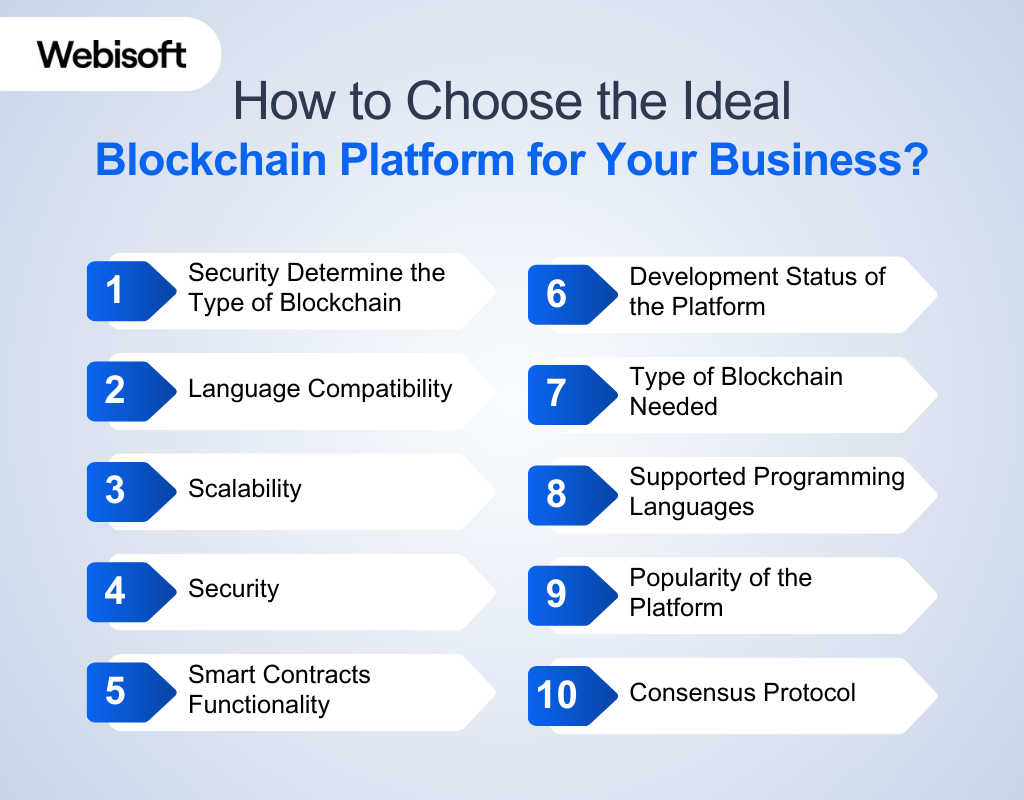
Selecting the right blockchain platform for your business is a critical decision that requires careful consideration. To guide your decision-making process, here are key considerations when evaluating blockchain platforms:
Determine the Type of Blockchain
Assess your business use case to identify whether a permissioned or permissionless blockchain is more suitable. Permissioned networks provide controlled access, while permissionless networks allow open participation. Understanding your specific needs will guide you towards the right type of blockchain.
Language Compatibility
Consider the programming languages supported by the blockchain platform. Ensure compatibility with your in-house development team’s skill set. Look for platforms that support popular languages like Python, Java, and JavaScript for efficient development.
Scalability
Evaluate the scalability of the blockchain platform in terms of its transaction processing capabilities. Align the platform’s capacity with your business’s transaction volume. Consider the expected workload and transaction speeds, measured in transactions per second (TPS).
Security
Prioritize security by selecting a platform with a strong track record in this aspect. Platforms like EOS and Hyperledger Fabric are known for robust security measures, making them suitable choices for organizations prioritizing data protection.
Smart Contracts Functionality
Not all platforms support smart contracts, which are essential for automating actions and enforcing rules on the blockchain. If smart contract functionality is crucial for your use case, ensure that the chosen platform provides this capability.
Development Status of the Platform
Ensure the platform can expand and adapt as the volume of transactions and participants rises. Consider factors like quality, affordability, and usability based on your application’s intensity.
Type of Blockchain Needed
Decide between public, private, or hybrid blockchains based on your business needs for accessibility, performance, permissions, and security.
Supported Programming Languages
Check the SDKs of a blockchain platform to understand which programming languages are covered, ensuring alignment with your team’s skill set.
Popularity of the Platform
Examine the platform’s standing on social media platforms like GitHub or Reddit to gauge its popularity and community support.
Consensus Protocol
Understand the consensus mechanism the platform employs, such as Proof of Work or Proof of Stake, to ensure compatibility with your project’s requirements.
By addressing these considerations, you can make a well-informed decision that aligns with your business goals and leverages the potential of blockchain technology.
What’s New in the Latest Blockchain Platforms
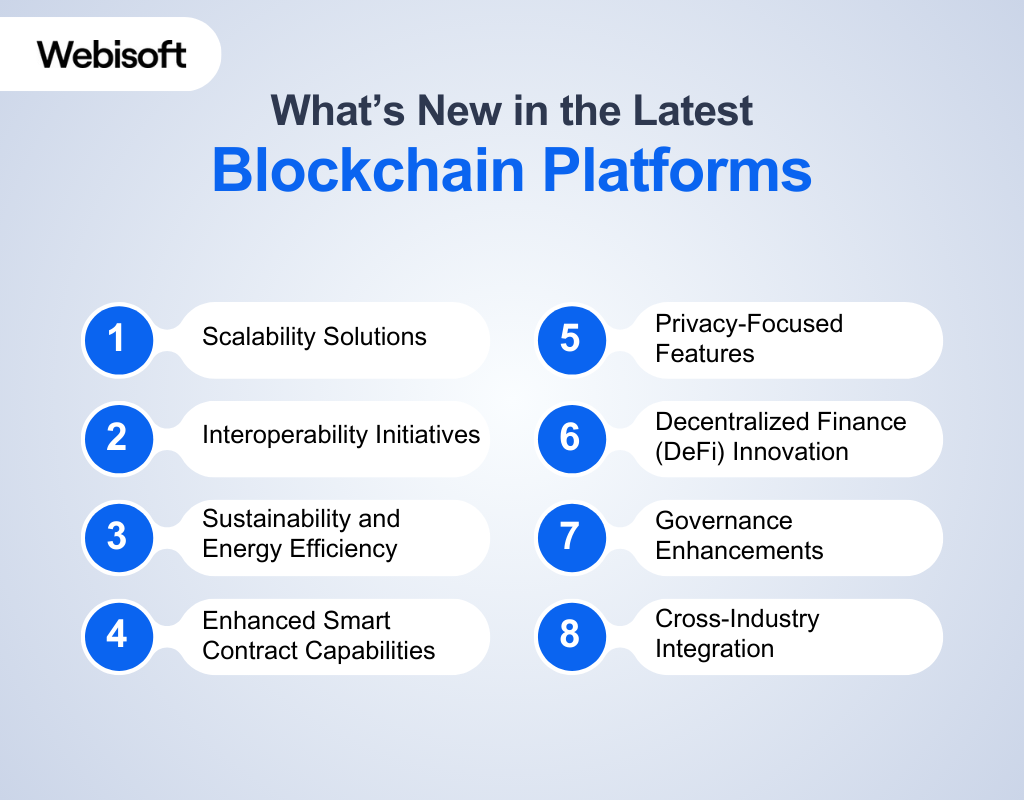
In the fast-paced world of blockchain innovation, recent platforms are not just incremental upgrades; they represent a paradigm shift towards more sustainable, scalable, and interoperable decentralized ecosystems. From enhanced privacy features to pioneering governance structures, these platforms are shaping the future of decentralized technologies.
As the blockchain space continues to evolve, staying informed about these advancements is crucial for businesses and developers seeking to harness the full potential of the latest blockchain platforms.
Here’s an in-depth exploration of what’s new in the latest blockchain platforms:
Scalability Solutions
Many contemporary blockchain platforms are actively addressing scalability concerns by implementing advanced consensus algorithms and layer-two solutions. These improvements aim to increase transaction throughput, reduce latency, and enhance overall network scalability. Solutions like sharding, sidechains, and off-chain scaling are gaining prominence to meet the growing demands of decentralized applications.
Interoperability Initiatives
Recognizing the importance of interoperability, newer blockchain platforms are placing a strong emphasis on compatibility with other networks. Interoperability initiatives, such as cross-chain communication protocols and standardized interfaces, enable seamless interaction between diverse blockchain ecosystems. This promotes collaboration and expands the potential use cases for decentralized technologies.
Sustainability and Energy Efficiency
In response to environmental concerns associated with proof-of-work (PoW) consensus mechanisms, some blockchain platforms are adopting more eco-friendly alternatives. The integration of proof-of-stake (PoS) or delegated proof-of-stake (DPoS) consensus mechanisms reduces energy consumption, aligning with the industry’s commitment to sustainability.
Enhanced Smart Contract Capabilities
Smart contracts are at the heart of decentralized applications, and the latest blockchain platforms are introducing enhanced smart contract capabilities. This includes improvements in scripting languages, security features, and the ability to execute more complex and intricate business logic directly on the blockchain.
Privacy-Focused Features
Privacy has become a paramount concern in blockchain networks, especially for applications dealing with sensitive data. Recent platforms are integrating privacy-focused features such as zero-knowledge proofs, ring signatures, and secure multi-party computation to safeguard user information and transaction details.
Decentralized Finance (DeFi) Innovation
The rise of decentralized finance has catalyzed innovative features within blockchain platforms. Newer networks are introducing native DeFi functionalities, including decentralized exchanges, lending protocols, and yield farming capabilities, providing users with more seamless and integrated financial services.
Governance Enhancements
Governance models in blockchain networks are evolving to be more inclusive and decentralized. Some platforms are introducing novel governance mechanisms, such as decentralized autonomous organizations (DAOs), to empower token holders in decision-making processes, fostering a more democratic and transparent ecosystem.
Cross-Industry Integration
Blockchain platforms are increasingly venturing into cross-industry integration, exploring applications beyond finance and cryptocurrencies. Industries such as healthcare, supply chain, and identity management are witnessing blockchain implementations, showcasing the technology’s potential to revolutionize diverse sectors.
Conclusion
In conclusion, Ethereum and Hyperledger Fabric stand out as influential blockchain platforms, each with unique strengths. However, selecting the ideal platform hinges on specific business requirements and objectives. As the landscape of blockchain technology evolves, staying informed about the latest advancements is crucial.
If you are ready to begin your blockchain journey, contact Webisoft today for expert blockchain solutions that make a difference.
FAQs
Is regulatory compliance a concern for blockchain platforms like Ethereum and Hyperledger Fabric?
Both Ethereum and Hyperledger Fabric address regulatory compliance concerns. Hyperledger Fabric, commonly used in enterprises, offers adaptability to industry-specific regulations, while Ethereum relies on community initiatives for compliance.
What are the energy consumption implications of platforms like EOS and Stellar?
EOS, with its Delegated Proof of Stake (DPoS) consensus, aims for energy efficiency. Stellar, utilizing the Stellar Consensus Protocol, focuses on faster transactions, contributing to relatively lower energy consumption.
How do Corda and Klaytn address interoperability with other blockchain networks?
Corda facilitates interoperability for financial transactions and smart contracts, while Klaytn emphasizes user-friendly development to promote interoperability across diverse applications and networks.
What is included in a blockchain ecosystem list?
A blockchain ecosystem list typically comprises blockchain platforms, frameworks, and networks essential for various applications. It encompasses leading technologies, their key features, and market insights, aiding businesses in choosing the right solution for their needs.
